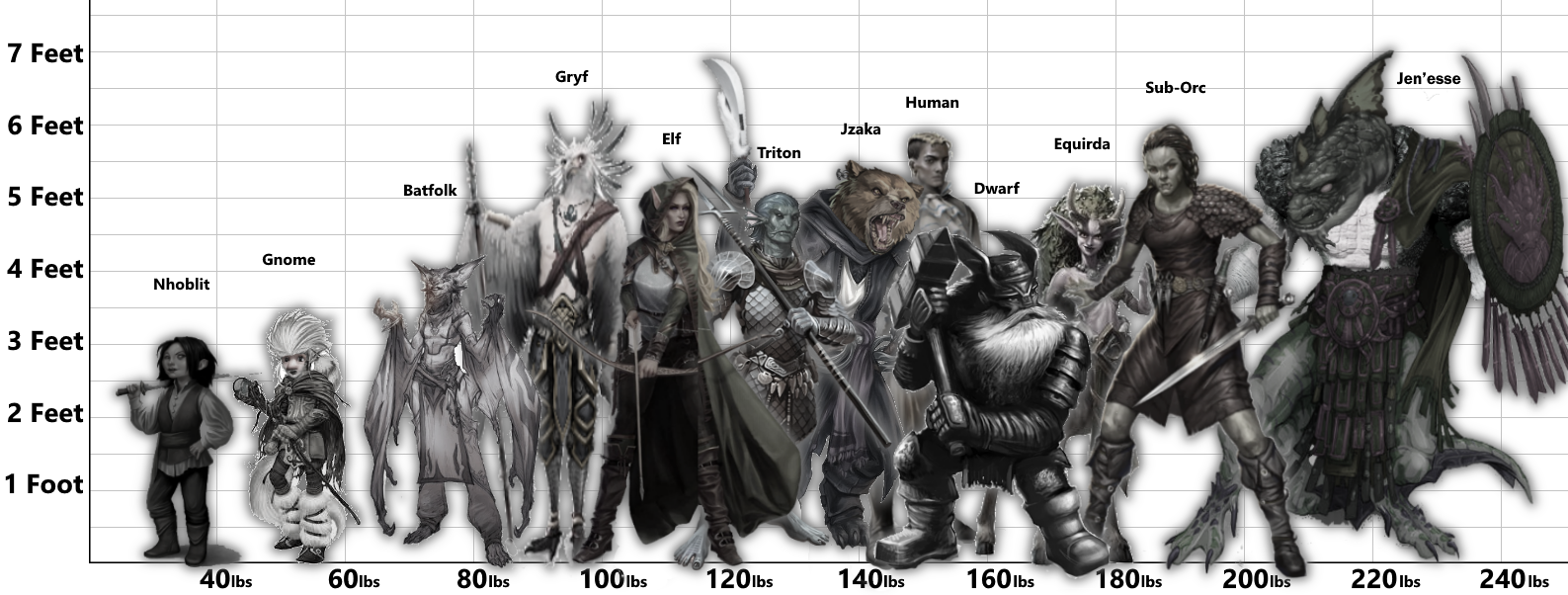Enchanted Realms Rulebook
Species Overview
There are those who do not like the term “species” and like to use “race” instead. The term “race” is historical in the genre of role-playing games. Species is a more accurate classification, and further, in the world of Enchanted Realms, none of the species are capable of interbreeding naturally. Thus, there are no half-elves. The one exception to this rule is the sub-orc. Orcs, which are not a playable species as they are uncivilized, cruel and have evil genetically infiltrated in their lifesongs, have a unique property to their breeding which allows them to impregnate any being of the anthropoid kingdom. Other than that exception, it would require a miracle or sorcery of some sort to create an offspring between a human and another kind.
The chart below the differences for attributes and other factors when choosing one of the twelve species which a player character can be. If the sub-attribute is adjusted at start up, it will be listed first. If that sub-attribute isn't adjusted, it will be noted with ∙ , a small bullet. The second number which is in [brackets] represents the maximum value that the species cab be improved to by natural means.
| Species | STR | AGIL | RESIL | LOGIC | PERC | JUDG | WILL | FAITH | MUSE |
|---|---|---|---|---|---|---|---|---|---|
| Batfolk | ∙ / [18] | +1 / [19] | ∙ / [18] | ∙ / [20] | ∙ / [20] | ∙ / [20] | -1 / [19] | ∙ / [20] | ∙ / [20] |
| Dwarf | ∙ / [20] | -1 / [17] | +2 / [21] | ∙ / [20] | -1 / [19] | ∙ / [20] | +1 / [21] | ∙ / [20] | ∙ / [20] |
| Elf | ∙ / [18] | +1 / [20] | -2 / [17] | ∙ / [20] | ∙ / [20] | ∙ / [18] | ∙ / [18] | ∙ / [17] | ∙ / [20] |
| Equirda | -2 / [17] | +2 / [21] | ∙ / [19] | ∙ / [20] | ∙ / [20] | ∙ / [20] | ∙ / [20] | -1 / [18] | -1 / [18] |
| Gnome | -1 / [18] | ∙ / [18] | ∙ / [18] | +2 / [21] | -1 / [18] | ∙ / [20] | ∙ / [20] | ∙ / [20] | +1 / [21] |
| Gryf | ∙ / [20] | +1 / [20] | -2 / [18] | ∙ / [20] | ∙ / [20] | ∙ / [20] | -1 / [19] | ∙ / [20] | ∙ / [20] |
| Human* | ∙ / [20] | ∙ / [20] | ∙ / [20] | ∙ / [20] | ∙ / [20] | ∙ / [20] | ∙ / [20] | ∙ / [20] | ∙ / [20] |
| Jen’esse | +1 / [20] | +1 / [20] | +1 / [20] | ∙ / [18] | ∙ / [20] | -1 / [17] | ∙ / [20] | ∙ / [20] | -2 / [17] |
| Jzaka | -1 / [19] | +1 / [21] | ∙ / [20] | ∙ / [18] | +1 / [22] | ∙ / [20] | ∙ / [18] | ∙ / [18] | -2 / [17] |
| Nhoblit | -2 / [16] | +2 / [19] | ∙ / [18] | ∙ / [20] | ∙ / [20] | ∙ / [20] | ∙ / [20] | ∙ / [20] | +1 / [20] |
| Orkane | +2 / [21] | ∙ / [19] | ∙ / [21] | -1 / [18] | ∙ / [19] | -1 / [18] | +2 / [20] | ∙ / [18] | -1 / [18] |
| Triton | ∙ / [20] | ∙ / [20] | -1 / [18] | ∙ / [20] | ∙ / [20] | ∙ / [20] | ∙ / [19] | -2 / [17] | ∙ / [18] |
| * A Human character is granted +2 bonus points applied by player choice. Further explanation below. | |||||||||
